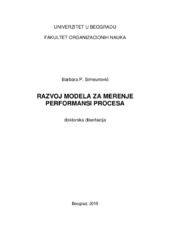Please use this identifier to cite or link to this item:
https://rfos.fon.bg.ac.rs/handle/123456789/78Full metadata record
| DC Field | Value | Language |
|---|---|---|
| dc.contributor.advisor | Radović, Milić | |
| dc.contributor.other | Slović, Dragoslav | |
| dc.contributor.other | Milanović, Dragan | |
| dc.creator | Simeunović, Barbara | |
| dc.date.accessioned | 2023-05-12T09:45:19Z | - |
| dc.date.available | 2023-05-12T09:45:19Z | - |
| dc.date.issued | 2015 | |
| dc.identifier.uri | http://eteze.bg.ac.rs/application/showtheses?thesesId=2945 | |
| dc.identifier.uri | https://nardus.mpn.gov.rs/handle/123456789/5481 | |
| dc.identifier.uri | https://fedorabg.bg.ac.rs/fedora/get/o:11191/bdef:Content/download | |
| dc.identifier.uri | http://vbs.rs/scripts/cobiss?command=DISPLAY&base=70036&RID=515512218 | |
| dc.identifier.uri | https://rfos.fon.bg.ac.rs/handle/123456789/78 | - |
| dc.description.abstract | Predmet istraživanja disertacije je mogucnost razvoja modela za merenje performansi procesa koji je fleksibilan i adaptibilan. Kako savremeno upravljanje organizacijom podrazumeva upravljanje njenim procesima, ostvarenje ciljeva organizacije zavisi od uspešnosti njenih procesa. Uspešnost procesa, odnosno sposobnost procesa da ispune ciljeve organizacije, se meri pomocu definisanih kljucnih indikatora performansi. Deo istraživanja se odnosi i na analizu meuzavisnosti ciljeva na najvišem nivou organizacije i indikatora uspešnosti procesa u kompanijama koje imaju primenjen procesni pristup. Istraživanje mogucnosti i nacina povecanja fleksibilnosti i adaptibilnosti sistema za merenje performansi procesa obuhvata opis i analizu poznatih modela za merenje performansi i razvoj autenticnog modela koji bi bio fleksibilan i adaptibilan. Razvoj modela obuhvata definisanje modela (elementi strukture, veze i meuzavisnosti), njegovu primenu u praksi i usavršavanje na osnovu ostvarenih rezultata. Disertacija potvruje opštu hipotezu: Formalizacijom meuzavisnosti ciljeva na najvišem nivou organizacije i indikatora uspešnosti kljucnih poslovnih procesa, moguce je unaprediti fleksibilnost i adaptibilnost sistema za merenje performansi poslovanja. Na osnovu analize obimne literature izvršen je naucni opis i uraena je komparativna analiza postojecih modela za merenje performansi procesa. Zatim je predložen novi, GPI model (eng. G – Goal; P – process; I – Indicator) za merenje performansi procesa koji omogucava identifikaciju direktne meuzavisnosti ciljeva na najvišem nivou organizacije i indikatora uspešnosti procesa, i ima odreenu fleksibilnost i adaptibilnost. Nakon toga je izvršeno istraživanje studije slucaja. Na osnovu dobijenih saznanja, prethodno koncipirani model je poboljšan i verifikovan. Rezultati istraživanja i razvijeni GPI model za merenje performansi procesa stvarju osnovu za kvalitetnije i lakše upravljanje performansama poslovanja, ali i za dalja istraživanja u ovoj oblasti. | sr |
| dc.description.abstract | The subject of the dissertation is the possibility of developing process performance measurement model that is flexible and adaptable. Since a contemporary management of the organization involves management of its processes, the achievement of organization’s goals depends on the success of its processes. The success of the process is measured by using key performance indicators. Part of the research is related to the analysis of the interdependencies of the highest level of organization’s goals and process performance indicators in companies that implemented a process approach. Research of possibilities and ways to increase the flexibility and adaptability of the process performance measurement system includes a description and analysis of the known performance measurement models and development of an authentic model that would be flexible and adaptable. Development involves model definition (elements of structure, links and interdependencies), its application in practice and its improvement, on a basis of achieved results. Main hypothesis developed and proved in the dissertation is: Formalization of interdependencies of the highest level of organization’s goals and key process performance indicators, makes it possible to improve the flexibility and adaptability of the business performance measurement systems. Based on analysis of the extensive literature, the scientific description and comparative analysis of existing process performance measurement models was conducted. Afterwards, the new GPI (G - Goal; P - process; I - Indicator) model is proposed. This process performance measurement model allows direct identification of interdependencies of the highest level goals and process performance indicators, and has a certain flexibility and adaptability. Then, the case study research was done. Based on the study findings, previously conceptualized model is improved. Results of research and proposed GPI model create the basis for better and easier performance management, but also for further research in this area. | en |
| dc.language | sr | |
| dc.publisher | Univerzitet u Beogradu, Fakultet organizacionih nauka | |
| dc.rights | openAccess | |
| dc.rights.uri | https://creativecommons.org/licenses/by-nc-nd/4.0/ | |
| dc.subject | struktura | sr |
| dc.subject | model | sr |
| dc.subject | Merenje performansi procesa | sr |
| dc.subject | kljucni procesi | sr |
| dc.subject | indikatori uspešnosti procesa | sr |
| dc.subject | fleksibilnost | sr |
| dc.subject | ciljevi | sr |
| dc.subject | adaptibilnost | sr |
| dc.subject | structure | en |
| dc.subject | Process performance measurement | en |
| dc.subject | process performance indicators | en |
| dc.subject | model | en |
| dc.subject | key processes | en |
| dc.subject | goals | en |
| dc.subject | flexibility | en |
| dc.subject | adaptibility | en |
| dc.title | Razvoj modela za merenje performansi procesa | sr |
| dc.title | Development of process performance measurement model. | en |
| dc.type | doctoralThesis | |
| dc.rights.license | BY-NC-ND | |
| dc.identifier.fulltext | http://prototype2.rcub.bg.ac.rs/bitstream/id/1157/74.pdf | |
| dc.identifier.rcub | https://hdl.handle.net/21.15107/rcub_nardus_5481 | |
| dc.identifier.rcub | t-3572 | |
| dc.type.version | publishedVersion | |
| item.cerifentitytype | Publications | - |
| item.fulltext | With Fulltext | - |
| item.grantfulltext | open | - |
| item.openairetype | doctoralThesis | - |
| item.openairecristype | http://purl.org/coar/resource_type/c_18cf | - |
| Appears in Collections: | Doktorati | |
Google ScholarTM
Check
This item is licensed under a Creative Commons License


